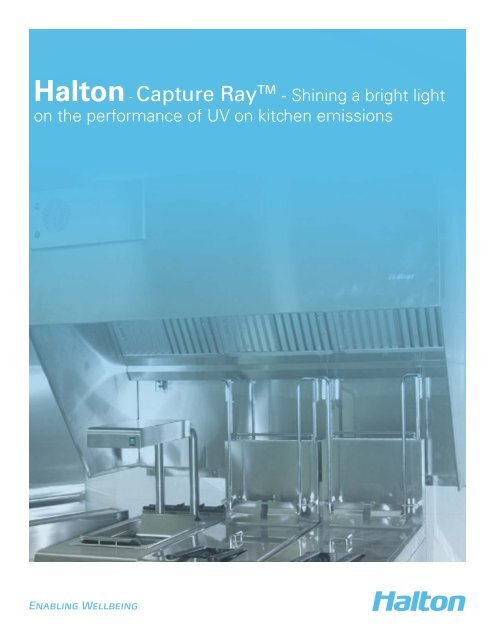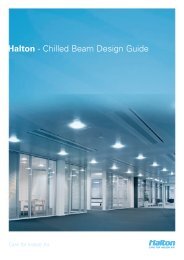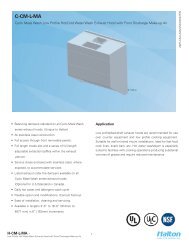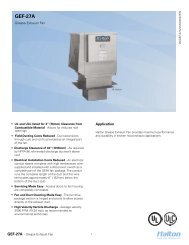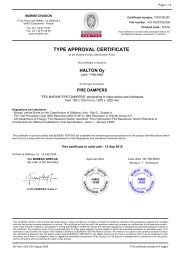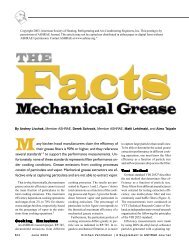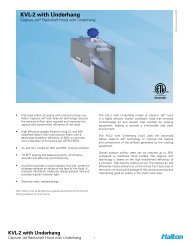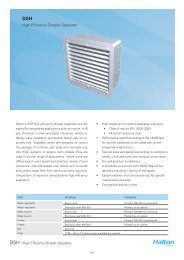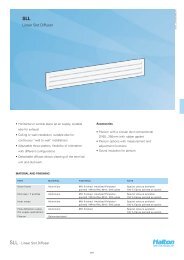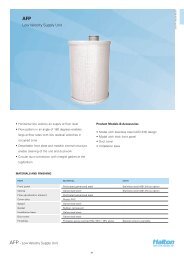Capture Ray Brochure - Halton Company
Capture Ray Brochure - Halton Company
Capture Ray Brochure - Halton Company
Create successful ePaper yourself
Turn your PDF publications into a flip-book with our unique Google optimized e-Paper software.
<strong>Halton</strong> - <strong>Capture</strong> <strong>Ray</strong> TM - Shining a bright light<br />
on the performance of UV on kitchen emissions<br />
Enabling Wellbeing
UV lamp cassette<br />
Built-in fan<br />
draws room air<br />
Small volume of air<br />
introduced at lip of<br />
hood increase face<br />
velocity<br />
Clean Operation,<br />
Clean Benefits<br />
<strong>Halton</strong> <strong>Capture</strong> Jet ® technology combined with<br />
innovative <strong>Capture</strong> <strong>Ray</strong>TM ultra-violet light technology.<br />
Scientifically proven results provide fire safety,<br />
reduced operating costs and lower environmental<br />
impact.<br />
• Cleaner exhaust ducts and plenum for improved<br />
hygiene and safety<br />
• Duct cleaning costs are reduced<br />
• Fast payback time and lower operating costs<br />
• Low air flow rates and energy savings with<br />
<strong>Capture</strong> Jet ® technology.<br />
• Comfortable working conditions and increased<br />
productivity in the kitchen<br />
• Scientifically tested system with world-wide<br />
references<br />
Assists capture and<br />
containment of cooking<br />
emissions<br />
Reduces exhaust air<br />
volumes requirements<br />
<strong>Capture</strong> <strong>Ray</strong> TM - Ultra Violet Technology
What is UV?<br />
Light is the most common form of electromagnetic<br />
radiation (EMR) that the average person is aware of.<br />
Light is only a very small band within the electromagnetic<br />
spectrum. Cosmic rays, X-rays, radio waves, television<br />
signals, and microwaves are other examples of EMR.<br />
EMR is characterized by its wavelength and frequency.<br />
Wavelength is defined as the length from the peak of<br />
one water to the peak of the next, or one oscillation<br />
(measured in meters). Frequency is the number of<br />
oscillations in one second (measured in Hertz).<br />
Sunlight is the most common source of ultraviolet<br />
radiation (UVR) but there are also many other sources.<br />
UVR emitting artificial light sources can be produced<br />
to generate any of the UVR wavelengths by using the<br />
appropriate materials and energies.<br />
Ultraviolet radiation is divided into three categories -<br />
UVA, UVB and UVC. These categories are determined<br />
by their respective wavelengths. Ultraviolet A radiation<br />
is the closest to the wavelength ranges of visible light.<br />
Ultraviolet B radiation is a shorter length, more energetic<br />
wave. Ultraviolet C radiation is the shortest of the three<br />
ultraviolet bands and is used for sterilization and germicidal<br />
applications.<br />
UV technology has been known since the 1800’s. In<br />
the past it has been utilized in hospitals, wastewater<br />
treatment plants and various industry applications.<br />
<strong>Halton</strong> has developed an applications to harness the<br />
power of ultraviolet technology in the commercial kitchen<br />
industry.<br />
UV - What does it do?<br />
Ultraviolet light reacts to small grease particulate and<br />
volatile organic compounds (VOC) generated in the<br />
cooking process in two ways, by exposing the effluent<br />
to light and by the generation of ozone (UVC).<br />
As is commonly known, effluent generated from<br />
the cooking process is grease. From a chemical<br />
standpoint, a fatty substance contains double bonds,<br />
which are more reactive then single bonds. By using<br />
light and ozone, it is possible to attack these double<br />
bonds and consequently, break them. This results in<br />
a large molecule being broken down into two smaller<br />
molecules. Ozone and Hydroxyl radicals then oxidize<br />
and alter the small grease molecules.<br />
<strong>Capture</strong> <strong>Ray</strong> TM - Ultra Violet Technology
UV-C Design considerations:<br />
Temperature plays a critical role in UV-C performance.<br />
When temperatures get above 160°F the efficiency of UV<br />
diminishes. For example, average entering air temperature<br />
of a cook-line with typical under-fired broiler is 100-110°F.<br />
If plenum temperatures are over 160° F temperatures –<br />
this is a unique cook-line and should be evaluated for UV-C<br />
effectiveness.<br />
There is also a loading factor. Vapor can be as much as<br />
40% of effluent. Mechanical extraction will not take this<br />
out. UV can be overloaded and an estimate must be made<br />
to determine the levels of vapor and time frame – but only<br />
if temperature conditions exist for UV-C performance,<br />
– loading is a secondary issue – the hotter the surface,<br />
generally more vapor.<br />
With <strong>Halton</strong> - it’s always a total solution<br />
Total system efficiency is the starting point for a fully operable UV system. The system design evaluates both exhaust<br />
and supply based on actual heat loads and <strong>Capture</strong> Jet ® efficiency.<br />
<strong>Halton</strong> <strong>Capture</strong> Jet ® high efficiency hoods are available with <strong>Capture</strong> <strong>Ray</strong> TM UV technology. <strong>Capture</strong> Jet ® hoods create<br />
a healthy and productive working environment by preventing the heat and impurities produced by cooking emissions<br />
from spreading into the work area. Compared to conventional exhaust-only hoods, <strong>Capture</strong> Jet ® is 30% more efficient<br />
while also reducing energy consumption due to lower airflow rates.<br />
This solution also includes the most advanced mechanical KSA filters, removing 95% of grease particles sized eight<br />
microns and above. Organic compounds are reduced by combining the best mechanical filtration available with the<br />
lowest possible operating air flows, thus giving the optimal residence time to the UV light and the longest working<br />
time to breakdown the grease molecules. Low pressure loss reduces energy consumption. These hoods also include<br />
T.A.B. system for easy testing and balancing.<br />
<strong>Capture</strong> <strong>Ray</strong> TM - Ultra Violet Technology
The 1 st Step in efficient UV conversion<br />
is to have...<br />
KSA Filters: The most efficient mechanical grease<br />
extractor on the market...!!!<br />
Total system efficiency is important to overall system<br />
performance which makes it extremely important the<br />
mechanical extractor utilized in the system removes as<br />
much grease particulate as possible.<br />
<strong>Halton</strong>’s KSA filter is a centrifugal filter that allows grease<br />
laden air to enter multiple chambers and rotate - slinging<br />
grease particles to the outer walls and removing them<br />
from the exhaust air stream. Think of soaking a towel in<br />
water and swinging it over your head...<br />
1. Exhaust air enters though a slot in the filter<br />
2. Exhaust air rotates through the filter, impinging<br />
grease on the filter walls<br />
3. The cleaner air exits the top and bottom of the filter<br />
Extraction Efficiency KSA vs Baffle Filters<br />
PM Extraction Efficiency (%) Overall Grease Extraction Efficiency (%)<br />
GREASE FILTER<br />
GRIDDLE FRYER BROILER GRIDDLE FRYER BROILER<br />
KSA 500, 144 cfm/ft 74.6 79.1 59.1 48.3 44.4 36.5<br />
KSA 500, 196 cm/ft 81.2 85.6 64.7 52.5 47.7 40.0<br />
KSA 500, 274 cfm/ft 84.7 88.6 67.5 54.8 49.3 41.7<br />
KSA 500, 365 cfm/ft 88.5 92.0 71.0 57.3 51.0 43.9<br />
KSA 330, 144 cfm/ft 78.7 82.9 62.5 50.9 46.3 38.6<br />
KSA 330, 196 cfm/ft 89.1 93.4 71.0 57.7 51.7 43.9<br />
KSA 330, 274 cfm/ft 87.9 91.2 70.5 56.8 50.6 43.6<br />
Baffle, 144 cfm/ft 19.0 20.5 14.9 12.3 14.0 9.2<br />
Baffle, 196 cfm/ft 28.0 29.9 22.2 18.1 18.9 13.7<br />
Baffle, 274 cfm/ft 51.5 54.8 40.7 33.3 31.8 25.2<br />
Baffle, 365 cfm/ft 65.2 69.3 51.6 42.2 39.3 31.9<br />
Research based on VDI 2052, Part 1, “Ventilation Equipment for Kitchens. Determination of <strong>Capture</strong> Efficiency<br />
of Aerosol Separators in Kitchen Exhaust. Note the bottom chart KSA 330 @ 196 cfm/ft compared with the baffle<br />
filter at 196 cfm/ft. On the top chart, note how the KSA efficiency remains high even when the filters are not<br />
cleaned and loading occurs.<br />
<strong>Capture</strong> <strong>Ray</strong> TM - Ultra Violet Technology
<strong>Capture</strong> <strong>Ray</strong> TM UV-C Hoods<br />
Many kitchens require emission control in their exhaust systems, to comply with the increasing demand for<br />
environmentally friendly operations. <strong>Halton</strong> <strong>Capture</strong> <strong>Ray</strong> TM hoods are based on <strong>Halton</strong>’s patented <strong>Capture</strong> Jet ® solution,<br />
advanced mechanical KSA extractor technology, and a UV-C system for the destruction of grease generated in the<br />
cooking process. Our UV-C technology is scientifically tested and includes all the necessary safety features. Together,<br />
these features result in clean ducts and improved fire safety.<br />
Odor control, smoke, and the appearance of exterior exhaust ducts are factors that need particularly careful consideration<br />
in food service environment design. <strong>Halton</strong>’s advanced air purification system is designed to be incorporated into<br />
commercial kitchen ventilation systems where control of airborne pollutants at the discharge point is a requirement.<br />
KVE-UV - <strong>Capture</strong> Jet ® Hood with UV Technology<br />
KVE <strong>Capture</strong> Jet ® hood equipped with high efficiency KSA grease<br />
extractors and Ultraviolet cassette(s) with complete controls and<br />
safety features.<br />
KVC-UV - <strong>Capture</strong> Jet ® Hood with Supply Air and UV Technology<br />
KVC <strong>Capture</strong> Jet ® hood equipped with low velocity supply air, high<br />
efficiency KSA grease extractors and Ultraviolet cassette(s) with<br />
complete controls and safety features.<br />
KVL-UV - Backshelf <strong>Capture</strong> Jet ® Hood with UV Technology<br />
KVL backshelf type <strong>Capture</strong> Jet ® hood equipped with high efficiency<br />
KSA grease extractors and Ultraviolet cassette(s) with complete<br />
controls and safety features.<br />
KVW-UV - <strong>Capture</strong> Jet ® Island Hood with UV Technology<br />
KVW <strong>Capture</strong> Jet ® Island hood equipped with a low velocity supply<br />
air unit, high efficiency KSA grease extractors and Ultraviolet cassette<br />
with complete controls and safety features.<br />
<strong>Capture</strong> <strong>Ray</strong> TM - Ultra Violet Technology
System Enhancements<br />
<strong>Halton</strong> EcoloAir TM units meet the increasingly stringent<br />
environmental demands and building regulations that<br />
have placed considerable limitations on the location<br />
of commercial kitchens. Odor control, smoke and the<br />
appearance of exterior exhaust ducts are all factors that<br />
need particularly careful consideration in foodservice<br />
environmental design.<br />
<strong>Halton</strong>’s ECOsystem is proactive in identifying filter<br />
replacement requirements by providing the end user<br />
with a clear visual indicator. The indicator shows filter<br />
life as a percentage filter loaded for each filtration stage<br />
or if filters are missing so operations can plan regular<br />
maintenance. With an optional web link, the system<br />
will send an email or text message to a designated<br />
service provider to schedule filter change during routine<br />
maintenance. This prevents any downtime during critical<br />
operating periods. <strong>Halton</strong> also offers the ECOsystem to<br />
be retrofitted to provide all the about mentioned benefits<br />
for already installed EcoloAir Systems.<br />
Each ventilation design presents its own unique<br />
challenges, for that reason <strong>Halton</strong> offers a line of hood<br />
accessories to address those project specific issues.<br />
M.A.R.V.E.L – Model based Automated Regulation of<br />
Ventilation Exhaust Levels – Demand Control system<br />
using infrared sensoring to match exhaust to appliance<br />
activities. Use to save energy.<br />
Water Wash – The automatic wash-down systems<br />
for hoods, which combine the <strong>Capture</strong> Jet ® system’s<br />
efficiency with filter and exhaust plenum cleaning. These<br />
maintain grease extractor performance and keep the<br />
entire system running at peak performance. With our<br />
advanced design the filters do not have to be removed<br />
from the hood, reducing labor costs.<br />
ABD – Automated Balancing Damper – works with<br />
<strong>Halton</strong>’s M.A.R.V.E.L. system for multiple hoods<br />
connected to a common exhaust system<br />
MBD – Manual Balancing Dampers – for easy balancing<br />
of exhaust airflow for multiple hoods connected to a<br />
common exhaust system<br />
TKHVAC TM - Total Kitchen HVAC ® reduces energy<br />
consumption and greenhouse gases while improving<br />
comfort through temperature and humidity control.<br />
EcoloAir TM<br />
Fire Suppression - Fire Suppression system can be<br />
designed to economically fit particular sizes of kitchen<br />
equipment and canopy arrangements.<br />
<strong>Capture</strong> <strong>Ray</strong> TM - Ultra Violet Technology
<strong>Halton</strong> – Enabling wellbeing in indoor environments<br />
<strong>Halton</strong> is a family owned company specializing in indoor climate and<br />
indoor environment products, services and solutions. <strong>Halton</strong>’s aim<br />
is to create comfortable and safe indoor environments with energyefficient<br />
and sustainable life cycle.<br />
<strong>Halton</strong> solutions range from public and commercial buildings to<br />
industry, commercial kitchen and restaurant applications. <strong>Halton</strong> is<br />
also one of the most recognized indoor climate solution providers<br />
for marine and offshore applications. Areas of expertise and product<br />
ranges cover air diffusion, airflow management, fire safety, kitchen<br />
ventilation, air purification and indoor environment management.<br />
<strong>Halton</strong> operates in 23 countries around the world. Headquarters are<br />
located in Finland and in the USA. Production facilities are located in<br />
Finland, France, Germany, Hungary, the UK, the USA, Canada and<br />
Malaysia. Indoor environment laboratories are located in the USA,<br />
France and Finland.<br />
www. haltoncompany.com<br />
<strong>Halton</strong> <strong>Company</strong><br />
101 Industrial Drive<br />
Scottsville, KY USA 42164<br />
Tel: (270) 237-5600 | Fax: (270) 237-5700<br />
<strong>Halton</strong> Indoor Climate Systems<br />
1021 Brevik Place<br />
Mississauga, ON, Canada L4W 3R7<br />
Tel: (905) 624-0301 | Fax: (905) 624-5547<br />
Enabling Wellbeing


